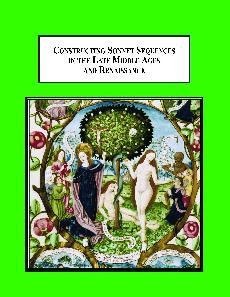Constructing Sonnet Sequences in the Late Middle Ages and Renaissance. A Study of Six Poets
We are currently unable to ship to the EU countries at this time. We apologize for this inconvenience.

| Author: | Kambaskovic-Sawers, Danijela | |
| Year: | 2010 | |
| Pages: | 428 | |
| ISBN: | 0-7734-3766-5 978-0-7734-3766-1 | |
| Price: | $259.95 + shipping | |
| (Click the PayPal button to buy) | ||
Establishes the presence of ambiguous, polyvalent characterisation of the first-person voice in the Petrarchan poem sequence. It argues that such characterisation triggers a reader-response mechanism characterised by ambivalence and interest which could be called splintered identification. This means of identifying helps promote reader-involvement and foster the perception of the sequence as an integral work, concerns which betray the presence of novelistic thinking. This book contains two color photographs.
Reviews
“. . . a distinctive blend of new historicism, feminism, narratology, genre theory and reception theory, as well as a good deal of excellent close reading. – Prof. Simon Haines
Chinese University of Hong Kong
“. . . offers a starting point for re-evaluation of how the sonnet sequence’s various manoeuvrings with characterization may have influenced the development of the novel.” – Prof. A.D. Cousins, Macquarie University
“. . . offers a starting point for re-evaluation of how the sonnet sequence’s various manoeuvrings with characterization may have influenced the development of the novel.” – Prof. A.D. Cousins, Macquarie University
Table of Contents
Foreword
Acknowledgments
Introduction
1. ‘A good length with my short thread’: Il Canzoniere and Splintered Identification
‘Never was I the golden cloud’: Ambiguous myth-making
‘Descend and climb’: The ambivalent speaker-poet
‘Your kiss [...] like your words’: Dualities of gender and desire
‘Shame’s fruit’: Variant ethics
2. ‘Fore-judging the after-following race’: Astrophil at Play with Ambiguity
‘A horseman to my horse, a horse to Love’: Astrophil and myth
‘Birth in death’: Ambivalence of gender and desire
‘Pitie the Tale of Me’: A fictional fiction-maker
‘Too high for my low stile’: Astrophil’s mock ethics
3. ‘Her stubborne hart to bend’: Amoretti and the Poetics of Ethical Challenge
‘Fly no more fayre loue from Phebus chace’: The myth-maker’s challenge
‘Men love theyr bane’: The challenge of manhood
‘Expresse her fill’: The author’s challenge
‘Eternal blisse’: The challenge of righteousness
4. ‘I see your craft, now I perceaue your drift’: Idea, Delia and the Architectonics of Entertainment
‘Bugbears in Apollo’s cell’: Entertaining by myth
‘Conceived with thought’: Entertaining by sexual subtext
‘The pack-horse way’: Writers’ confessions
‘Imortall smoke’: Entertaining by ethical revision
5. ‘Three themes in one, which wondrous scope affords’: Shakespeare’s Sonnets and the Ascendancy of the Story
‘A satire to decay’: Polyvalent mythical figures
‘My seat forbear’: Ironies of gender and desire
‘Bastard signs of fair’: Innovative autopoetics
‘Benefit of ill’: Desperate ethics
Conclusion
Select Bibliographies
General Bibliography
Bibliography Chapter 1 (Francesco Petrarch, Il Canzoniere)
Bibliography Chapter 2 (Sir Philip Sidney, Astrophil and Stella)
Bibliography Chapter 3 (Edmund Spenser, Amoretti)
Bibliography Chapter 4 (Samuel Daniel, Delia, Michael Drayton, Idea)
Bibliography Chapter 5 (William Shakespeare, Shakespeares Sonnets)
Acknowledgments
Introduction
1. ‘A good length with my short thread’: Il Canzoniere and Splintered Identification
‘Never was I the golden cloud’: Ambiguous myth-making
‘Descend and climb’: The ambivalent speaker-poet
‘Your kiss [...] like your words’: Dualities of gender and desire
‘Shame’s fruit’: Variant ethics
2. ‘Fore-judging the after-following race’: Astrophil at Play with Ambiguity
‘A horseman to my horse, a horse to Love’: Astrophil and myth
‘Birth in death’: Ambivalence of gender and desire
‘Pitie the Tale of Me’: A fictional fiction-maker
‘Too high for my low stile’: Astrophil’s mock ethics
3. ‘Her stubborne hart to bend’: Amoretti and the Poetics of Ethical Challenge
‘Fly no more fayre loue from Phebus chace’: The myth-maker’s challenge
‘Men love theyr bane’: The challenge of manhood
‘Expresse her fill’: The author’s challenge
‘Eternal blisse’: The challenge of righteousness
4. ‘I see your craft, now I perceaue your drift’: Idea, Delia and the Architectonics of Entertainment
‘Bugbears in Apollo’s cell’: Entertaining by myth
‘Conceived with thought’: Entertaining by sexual subtext
‘The pack-horse way’: Writers’ confessions
‘Imortall smoke’: Entertaining by ethical revision
5. ‘Three themes in one, which wondrous scope affords’: Shakespeare’s Sonnets and the Ascendancy of the Story
‘A satire to decay’: Polyvalent mythical figures
‘My seat forbear’: Ironies of gender and desire
‘Bastard signs of fair’: Innovative autopoetics
‘Benefit of ill’: Desperate ethics
Conclusion
Select Bibliographies
General Bibliography
Bibliography Chapter 1 (Francesco Petrarch, Il Canzoniere)
Bibliography Chapter 2 (Sir Philip Sidney, Astrophil and Stella)
Bibliography Chapter 3 (Edmund Spenser, Amoretti)
Bibliography Chapter 4 (Samuel Daniel, Delia, Michael Drayton, Idea)
Bibliography Chapter 5 (William Shakespeare, Shakespeares Sonnets)
